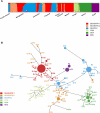Limited geographical origin and global spread of sulfadoxine-resistant dhps alleles in Plasmodium falciparum populations
- PMID: 22021623
- PMCID: PMC3209816
- DOI: 10.1093/infdis/jir664
Limited geographical origin and global spread of sulfadoxine-resistant dhps alleles in Plasmodium falciparum populations
Abstract
Background: Plasmodium falciparum malaria resistant to chloroquine and pyrimethamine originated in limited foci and migrated to Africa. It remains unresolved whether P. falciparum resistance to sulfadoxine, which is conferred by mutations in dihydropteroate synthase (DHPS), evolved following a similar pattern.
Methods: The dhps locus of 893 P. falciparum isolates from 12 countries in Asia, the Pacific Islands, Africa, and South America was sequenced. Haplotypes of 6 microsatellite loci flanking the dhps locus were determined to define the genetic relationships among sulfadoxine-resistant lineages.
Results: Six distinct sulfadoxine-resistant lineages were identified. Highly resistant lineages appear to have originated only in Southeast Asia and South America. Two resistant lineages found throughout Southeast Asia have been introduced to East Africa, where they appear to have spread.
Conclusions: The infrequent selection of parasites highly resistant to sulfadoxine and the subsequent migration of resistant lineages from Asia to Africa are similar to the patterns observed in chloroquine and pyrimethamine resistance. These findings strongly suggest that the global migration of resistant parasites has played a decisive role in the establishment of drug-resistant P. falciparum parasites, and that similar patterns may be anticipated for the spread of artemisinin resistance.
Figures



References
-
- World Health Organization. World Malaria Report 2008. Geneva, Switzerland: World Health Organization, 2008.
-
- Grobusch MP, Egan A, Gosling RD, Newman RD. Intermittent preventive therapy for malaria: progress and future directions. Curr Opin Infect Dis. 2007;20:613–20. - PubMed
-
- Mita T, Tanabe K, Kita K. Spread and evolution of Plasmodium falciparum drug resistance. Parasitol Int. 2009;58:201–9. - PubMed
Publication types
MeSH terms
Substances
Grants and funding
LinkOut - more resources
Full Text Sources
Other Literature Sources

